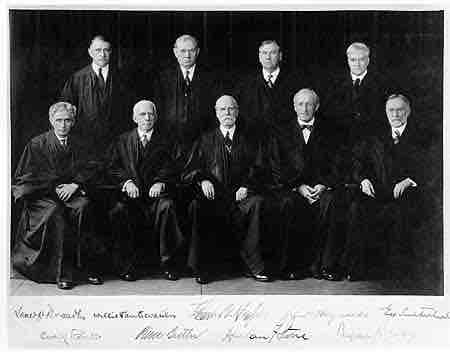OPPOSITION TO THE NEW DEAL
When Franklin Delano Roosevelt took over the office in 1933, the economic situation in the United States was so disastrous that initially, the New Deal agenda provoked limited political opposition and enjoyed vast public support. Unlike his predecessor, Roosevelt proposed sweeping reform, recovery, and relief programs at the time when hope and optimism were scarce. Although many First New Deal (1933-1934/5) policies were controversial and triggered criticism among representatives of business, politics, labor, and experts, they demonstrated that the new administration took immediate action, which most agreed was necessary. However, the Second Deal (1934/5-1938) provoked much more fervent criticism, particularly in conservative circles. Both Republicans and conservative Democrats grew concerned with the expansion of the regulative role of the federal government and the unprecedented impact that the president had on legislation. Business leaders also joined the ranks of New Deal critics as the legislation continued to expand workers' rights as well as regulate production and trade practices.
THE AMERICAN LIBERTY LEAGUE
The American Liberty League was a non-partisan organization formed in 1934 in opposition to the New Deal. The League gathered Republicans, Democrats, and business leaders who opposed the New Deal's premise that the government not only could but should intervene in the economy. The organization's stated goal was "to defend the Constitution and defend the rights and liberties guaranteed by that Constitution." Its members believed that the New Deal's regulative nature threatened Constitution-given individual liberties and expanded the executive power beyond what the Constitution intended (some decisions of the Supreme Court that declared certain New Deal policies unconstitutional suggest that this criticism was not unfunded). The League engaged in campaigns, in which it aimed to educate the public about the legislative process.
While the League's members were divided over the National Recovery Administration, they fervently criticized the Agricultural Adjustment Administration (calling it "a trend toward Fascist control of agriculture") and Social Security (which they saw a marking "the end of democracy"). The League's lawyers also challenged the 1936 National Labor Relations Act but the Supreme Court upheld its constitutionality. After Roosevelt's 1936 victory, the League slowly dissolved, disappearing entirely in 1940. Historians argue that its relatively small impact was a result of misjudging the reality of the extreme economic crisis, in which references to individual liberties were less appealing than concrete, even if controversial, reform projects.
THE COURT PACKING
In the Aftermath of the 1936 election, Roosevelt proposed the Judicial Procedures Reform Bill of 1937 that would be commonly known as the "court-packing plan." Its aim was to add up to six more justices to the U.S. Supreme Court, one for each member of the court over the age of 70 years and 6 months. The goal was to change the political balance of the Court and ensure the Court's support for the New Deal legislation. The proposal provoked vast opposition, including among some liberals. It also united conservatives in both parties. While Burton Wheeler, a progressive Democrat from Montana, played the role of the public voice of the alliance that formed in opposition to the court-packing plan, conservative Democratic senators, Carter Glass, Harry Flood Byrd, and Josiah Bailey, were critical to collecting enough opposing votes in Congress. Roosevelt realized that the bill had no chance of being passed and a compromise that did not alter the existing balance in the Court was negotiated.
CONSERVATIVE COALITION
The court-packing plan strengthened conservative opposition to the New Deal. By 1937, an informal yet strong group of congressmen and representatives opposing the New Deal formed in Congress. Known as the Conservative Coalition (at the time, the term "conservative" referred to the opponents of the New Deal and did not imply any specific party affiliation), it initiated a conservative alliance that, with modifications, shaped Congress until the 1960s. In 1937, Bailey released a "Conservative Manifesto" that presented conservative philosophical tenets, including the line "Give enterprise a chance, and I will give you the guarantees of a happy and prosperous America." The Manifesto called for reduced governments spending, balanced budget, and lowering taxes. It also emphasized the importance of private enterprise and suggested that the position of unions was too powerful. Over 100,000 copies were distributed and the document marked a turning point in terms of congressional support for the New Deal legislation. The Coalition's members did not form a solid anti-New Deal legislation voting bloc. Instead, they responded to each proposed law depending on how much, in their opinion, it violated the conservative principles that they supported.
The results of the 1938 midterm election demonstrated that the dissatisfaction with New Deal policies grew. In the Democratic primaries, Roosevelt endorsed the challengers of his conservative opponents but the anti-New Deal incumbents won. In the national election, more conservative candidates won seats in Congress with Republicans recording substantial gain in both House and Senate.
THE BUSINESS PLOT
The Business Plot (known as the White House Coup) was a 1933 political conspiracy against Roosevelt. Smedley Butler, a retired Marine Corps Major General, testified before the Special Committee on Un-American Activities that wealthy businessmen were plotting to create a fascist veterans' organization to overthrow the President. No one was prosecuted. While historians have questioned whether or not a coup was actually close to execution, most agree that some sort of "wild scheme" was contemplated and discussed. Contemporary media dismissed the plot, with a New York Times editorial characterizing it as a "gigantic hoax".

U.S. Supreme Court, 1932
Roosevelt threatened to overcome judicial opposition to New Deal legislation by "packing" the court with his own appointees.